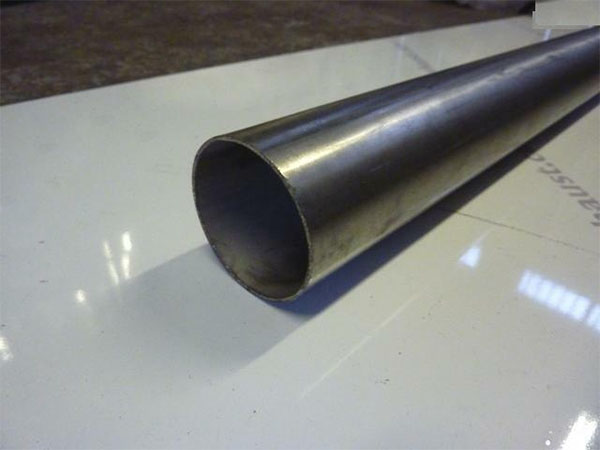Stainless steel exhaust pipes are key components used in the exhaust systems of automobiles, motorcycles and industrial equipment. Their main function is to guide the discharge of exhaust gases and withstand high temperatures, corrosion and mechanical vibrations. Compared with carbon steel, stainless steel has better strength retention and oxidation resistance in high-temperature environments, which can significantly extend the service life of the exhaust system and improve overall reliability.
Central Steel is a leading manufacturer, exporter and distributor of steel pipes and fittings in China. It produces and sells high-quality stainless steel exhaust pipes and provides comprehensive services to customers.

The manufacturing process of stainless steel exhaust pipes
Raw materials: Through hot-rolled or cold-rolled stainless steel strips, they are rolled and then welded (ERW) or seamlessly extruded
(Seamless) to ensure uniform pipe walls and no mechanical defects.
Straightening and correction: After forming, the steel pipe is straightened by a straightening machine to eliminate internal stress and slight bending, ensuring the straightness of the pipe body. For complex pipelines, precise bending is achieved through a CNC pipe bender or mandrel bending (mold core bending), keeping the inner diameter unchanged to optimize the exhaust flow rate.
Welding and assembly: TIG or MIG welding is commonly used for the connection between the manifold and the muffler. The weld seam should be continuous, uniform, and maintain good oxidation resistance at high temperatures. Argon arc passivation treatment is often carried out after welding to restore the corrosion-resistant film on the metal surface.
Common materials and grades of stainless steel exhaust pipes
"304 Series"
304 (Type 18/8) : It contains approximately 18% chromium and 8% nickel. It has excellent oxidation resistance and corrosion resistance, and its surface is easy to polish. It is often used in the exhaust systems of high-end automobiles and racing cars. It can remain bright for a long time even in a damp or salty environment.
400 series
409: It has the lowest cost and good weldability, and is suitable for conventional exhaust systems with general requirements for corrosion resistance. However, in harsh environments (such as salt-sprinkled roads in winter), surface rust spots are prone to occur.
439: Between 409 and 304, it contains approximately 18% chromium and has a low nickel content (≈0.5%). It combines good corrosion resistance and cost-effectiveness, and is commonly found in mid-range exhaust systems.
Special alloy
321: By adding titanium to 304, it enhances the resistance to intergranular corrosion and is suitable for long-term high-temperature (> 450°C) heat exchangers and exhaust manifolds applications.
316: It contains molybdenum to enhance its resistance to chloride corrosion and is mostly used in offshore or chemical environments. However, due to its high cost, it is less adopted in automotive exhaust.
Performance and Advantages
High-temperature resistance: Stainless steel can be used for a long time within 800℃, with a high softening temperature at the weld seam, making it suitable for turbocharged and high-performance engines.
Corrosion resistance: The chromium oxide film has a strong self-healing ability and can remain intact in damp, sulfur-containing or chlorine-containing environments, reducing pitting and crevice corrosion.
Strength and vibration resistance: It has higher strength than carbon steel, excellent fatigue resistance, can withstand engine vibration and road impact, and reduce the risk of cracking.
Standards and Specifications
ASTM A312/A778: Technical specification for stainless steel seamless and welded pipes by the American Society for Testing and Materials, covering chemical composition, mechanical properties and test methods.
ISO 1127/ISO 9327: Requirements of the International Organization for Standardization for the dimensions, tolerances and welding performance of stainless steel pipes, which are widely used in global pipeline systems.
SAE J431/J844: The Society of Automotive Engineers of the United States proposes specific test methods for the high-temperature strength and corrosion resistance of metal materials in exhaust systems.
Key points for selection
Pipe diameter and wall thickness: According to the exhaust volume and flow rate requirements, select the appropriate nominal diameter (NPS/DN) and wall thickness (such as 1.5mm - 3mm) to balance flow resistance and strength.
Thermal expansion and vibration: Expansion joints or flexible joints should be reserved, and combined with the vibration reduction design of the support, to prevent pipeline deformation or fatigue rupture at high temperatures.
Surface treatment: Sandblasting, brushing, mirror polishing or electrochemical passivation are available as options to enhance the aesthetic appeal and strengthen the corrosion-resistant film.
Welding process: TIG welding requires strict control over the composition of the welding wire and the welding temperature. The back of the weld seam needs to be protected by argon blowing to prevent intergranular corrosion.
